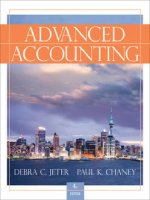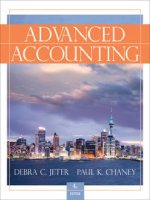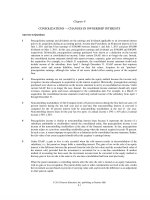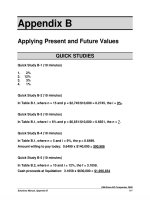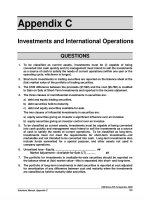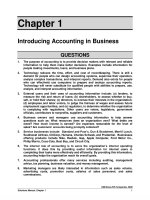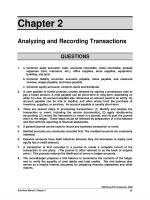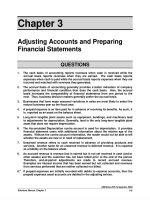Solution manual financial accounting 4e by wild chapter08
Bạn đang xem bản rút gọn của tài liệu. Xem và tải ngay bản đầy đủ của tài liệu tại đây (1.12 MB, 41 trang )
To download more slides, ebook, solutions and test bank, visit
Chapter 8
Reporting and Analyzing
Long-Term Assets
QUESTIONS
1.
A plant asset is tangible; it is used in the production or sale of other assets or services; and
it has a useful life longer than one accounting period.
2.
The cost of a plant asset includes all normal and reasonable expenditures necessary to get
the asset in place and ready for its intended use.
3.
Land is an asset with an unlimited life and, therefore, is not subject to depreciation. Land
improvements have limited lives and are subject to depreciation.
4.
Often the lump-sum or basket purchase includes assets with different lives that must be
depreciated separately. Sometimes the purchase may include land, which is never
depreciated.
5.
The Accumulated Depreciation—Machinery account is a contra asset account with a credit
balance that cannot be used to buy anything.
The balance of the Accumulated
Depreciation—Machinery account reflects that portion of the machinery's original cost that
has been charged to depreciation expense. It also gives some indication of the asset‘s age
and how soon it will need to be replaced. Any funds available for buying machinery are
shown on the balance sheet as liquid assets with debit balances.
6.
The Modified Accelerated Cost Recovery System is not generally acceptable for financial
accounting purposes because it allocates depreciation over an arbitrary period that is
usually much shorter than the predicted useful life of the asset.
7.
The materiality principle justifies charging low-cost plant asset purchases to expense
because such amounts are unlikely to impact the decisions of financial statement users.
8.
Ordinary repairs are made to keep a plant asset in normal, good operating condition, and
should be charged to expense of the current period. Extraordinary repairs are made to
extend the life of a plant asset beyond the original estimated life; they are recorded as capital
expenditures (and added to the asset account).
9.
A company might sell or exchange an asset when it reaches the end of its useful life, or if it
becomes inadequate or obsolete, or if the company has changed its business plans. An
asset also can be damaged or destroyed by fire or some other accident that would require its
disposal.
10. The process of allocating the cost of natural resources to expense over the periods when
they are consumed is called depletion. The method to compute depletion is similar to unitsof-production depreciation.
©McGraw-Hill Companies, 2008
Solutions Manual, Chapter 8
421
To download more slides, ebook, solutions and test bank, visit
11. No, depletion expense should be calculated on the units that are extracted (similar to the
units-of-production basis) and sold.
12. An intangible asset: (1) has no physical existence; (2) derives value from the unique legal
and contractual rights held by its owner; and (3) is used in the company‘s operations.
13. Intangible assets are generally recorded at their cost and amortized over their predicted
useful life. (However, some costs are not included, such as the research and development
costs leading up to a patent.) The costs of intangible assets are generally allocated to
amortization expense using the straight-line method over their useful lives. If the useful life
of an intangible asset is indefinite, then it is not amortized—instead, it is annually tested for
impairment.
14. A company has goodwill when its value exceeds the value of its individual assets and
liabilities. Goodwill appears in the balance sheet when one company acquires another
company or separate segment and pays a price that exceeds the combined values of all its
net assets (assets less liabilities) excluding goodwill.
15.
No; this type of goodwill would not be amortized. Instead, the FASB (SFAS 142) requires that
goodwill be annually tested for impairment. If the book value of goodwill does not exceed its
fair (market) value, goodwill is not impaired. However, if the book value of goodwill exceeds
its fair value, an impairment loss is recorded equal to that excess. (Details of this two-step
test are in advanced courses.)
16. Total asset turnover is calculated by dividing net sales by average total assets. Financial
statement users can use total asset turnover to evaluate the efficiency of a company in using
its assets to generate sales.
17. Best Buy lists Land and buildings; Leasehold improvements; Fixtures and equipment;
Property under master and capital lease. The book value of these assets is $2,464,000,000.
18. Circuit City calls its plant assets ―Property and equipment, net.‖ The book value of the
property and equipment is $738,802,000
19. Apple‘s Long term assets discussed in this chapter are: Property, plant, and equipment, net;
Goodwill; Acquired intangible assets.
©McGraw-Hill Companies, 2008
422
Financial Accounting, 4th Edition
To download more slides, ebook, solutions and test bank, visit
QUICK STUDIES
Quick Study 8-1 (10 minutes)
Recorded cost = $190,000 + $20,000 + $4,000 + $13,700 = $227,700
Note: The $1,850 repair charge is an expense because it is not a normal and reasonable
expenditure necessary to get the asset in place and ready for its intended use.
Quick Study 8-2 (10 minutes)
1. The main difference between plant assets and current assets is that
current assets are consumed or converted into cash within a short
period of time, while plant assets have a useful life of more than one
accounting period.
2. The main difference between plant assets and inventory is that
inventory is held for resale and plant assets are not.
3. The main difference between plant assets and long-term investments is
that plant assets are used in the primary operation of the business and
investments are not.
Quick Study 8-3 (10 minutes)
1. Straight-line
($65,800 - $2,000) / 4 years = $15,950 depreciation per year
2. Units-of-production
($65,800 - $2,000) / 200 concerts =
$
319 depreciation per concert
x 45 concerts in 2008
$14,355 depreciation in 2008
Quick Study 8-4 (10 minutes)
$65,800 Cost
- 15,950 Accumulated depreciation (first year)
49,850 Book value at point of revision
- 2,000 Salvage value
47,850 Remaining depreciable cost
÷ 2 Years of life remaining
$23,925 Depreciation per year for years 2 and 3
©McGraw-Hill Companies, 2008
Solutions Manual, Chapter 8
423
To download more slides, ebook, solutions and test bank, visit
Quick Study 8-5 (10 minutes)
Note: Double-declining-balance rate = (100% / 8 years) x 2 = 25%
First year:
$830,000 x 25%
= $207,500
Second year:
($830,000 - $207,500) x 25%
= $155,625
Third year:
($830,000 - $207,500 - $155,625) x 25%
= $116,719* (rounded)
* Total accumulated depreciation of $479,844 ($207,500 + $155,625 + $116,719)
does not exceed the depreciable cost of $755,000 ($830,000 - $75,000).
Quick Study 8-6 (10 minutes)
1. (a) Capital expenditure
(b) Revenue expenditure
(c) Revenue expenditure
(d) Capital expenditure
2. (a)
Equipment................................................................
Cash ..................................................................
40,000
40,000
To record addition of a new wing.
(d) Building .................................................................... 225,000
Cash ..................................................................
225,000
To record an extraordinary repair.
©McGraw-Hill Companies, 2008
424
Financial Accounting, 4th Edition
To download more slides, ebook, solutions and test bank, visit
Quick Study 8-7 (15 minutes)
Book value of old machine = $76,800 - $40,800 = $36,000
1.
Cash ................................................................................
Accumulated depreciation ............................................
47,000
40,800
Equipment ......................................................................
Gain on sale of equipment* ...........................................
To record the sale of equipment.
*(Gain = $47,000 - $36,000)
2.
Cash ................................................................................
Accumulated depreciation ............................................
76,800
11,000
36,000
40,800
Equipment ......................................................................
To record the sale of equipment.
3.
Cash ................................................................................
Accumulated depreciation ............................................
Loss on sale of equipment
76,800
31,000
40,800
5,000
Equipment ......................................................................
To record the sale of equipment.
*(Loss = $31,000 - $36,000)
76,800
Quick Study 8-8 (10 minutes)
1.
Ore Mine..........................................................................1,800,000
Cash .........................................................................
1,800,000
To record cost of ore mine.
2.
Depletion per unit =
$1,800,000 - $200,000
1,000,000 tons
= $1.60 per ton
Depletion Expense—Ore Mine ...................................... 288,000
Accumulated Depletion—Ore Mine .......................
288,000
To record depletion of ore mine (180,000 x $1.60).
Quick Study 8-9 (10 minutes)
Intangible Assets:
b) Trademark c) Leasehold f) Copyright g) Franchise
Natural Resources: a) Oil well
Note:
d) Gold mine h) Timberland
Building is reported under plant assets.
©McGraw-Hill Companies, 2008
Solutions Manual, Chapter 8
425
To download more slides, ebook, solutions and test bank, visit
Quick Study 8-10 (10 minutes)
1.
Jan. 4 Leasehold Improvements ...............................................
105,000
Cash..........................................................................
105,000
To record leasehold improvements.
2.
Dec. 31 Amortization Expense–Leasehold Improvements ............
13,125
Accumulated Amortization—Leasehold
Improvements .........................................................
13,125
To record amortization of leasehold over
the remaining life of the lease.*
*
Amortization = $105,000 / 8-year-lease-term = $13,125 per year.
Quick Study 8-11 (10 minutes)
Total asset turnover =
($ millions)
$14,880
($15,869 + $17,819) / 2
= 0.88 times
Interpretation: The company‘s turnover of 0.88 times is markedly lower than
its competitors‘ turnover of 2.0. This company must perform better if it is to
be successful in the long run.
Quick Study 8-12A (10 minutes)
Book value of old machine = $42,400 - $18,400 = $24,000
1.
Machinery (new) ........................................................
Accumulated Depreciation–Machinery (old) ..........
Loss on Exchange of Assets* ..................................
Machinery (old) .................................................
Cash ...................................................................
52,000
18,400
2,000
42,400
30,000
To record asset exchange assuming commercial
substance. *$52,000 – ($24,000 + $30,000) = $(2,000)
2.
Machinery (new)* .......................................................
Accumulated Depreciation–Machinery (old) ..........
Machinery (old) .................................................
Cash ...................................................................
46,000
18,400
42,400
22,000
To record asset exchange assuming lack of
commercial substance.
*Book value of old asset + cash given = $24,000 + $22,000
©McGraw-Hill Companies, 2008
426
Financial Accounting, 4th Edition
To download more slides, ebook, solutions and test bank, visit
EXERCISES
Exercise 8-1 (15 minutes)
Invoice price of machine .........................................................
$ 12,500
Less discount (.02 x $12,500) .................................................(250)
Net purchase price...................................................................
12,250
Freight charges (transportation-in) ........................................ 360
Mounting and power connections ......................................... 895
Assembly .................................................................................. 475
Materials used in adjusting ..................................................... 40
Total cost to be recorded ........................................................
$ 14,020
Exercise 8-2 (15 minutes)
Cost of land
Purchase price for land ...........................................................
$ 280,000
Purchase price for old building ..............................................
110,000
Demolition costs for old building ...........................................
33,500
Costs to fill and level lot .........................................................
47,000
Total cost of land .....................................................................
$ 470,500
Cost of new building and land improvements
Cost of new building ...............................................................
$1,452,200
Cost of land improvements ....................................................
87,800
Total construction costs .........................................................
$1,540,000
Journal entry
Land ................................................................................ 470,500
Land Improvements .......................................................
87,800
Building .......................................................................... 1,452,200
Cash ..........................................................................
2,010,500
To record costs of plant assets.
©McGraw-Hill Companies, 2008
Solutions Manual, Chapter 8
427
To download more slides, ebook, solutions and test bank, visit
Exercise 8-3 (20 minutes)
Purchase price ...........................................................
Closing costs .............................................................
Total cost of acquisition ...........................................
$375,280
20,100
$395,380
Allocation of total cost
Appraised
Value
Land .............................. $157,040
Land improvements ......
58,890
Building......................... 176,670
Totals ............................ $392,600
Percent
of Total
Applying %
to Cost
Apportioned
Cost
40%
15
45
100%
$395,380 x .40
$395,380 x .15
$395,380 x .45
$158,152
59,307
177,921
$395,380
Journal entry
Land .......................................................................... 158,152
Land Improvements ................................................ 59,307
Building .................................................................... 177,921
Cash ..................................................................
395,380
To record costs of lump-sum purchase.
Exercise 8-4 (20 minutes)
1. Straight-line depreciation: ($154,000 - $25,000) / 4 years = $32,250 per year
Year
Annual Depreciation Year-End Book Value
2007 ........
$ 32,250
$121,750
2008 ........
32,250
89,500
2009 ........
32,250
57,250
2010 ........
32,250
25,000
Total .......
$129,000
2. Double-declining-balance depreciation
Depreciation rate: 100% / 4 years = 25% x 2 = 50%
Beginning-Year Depreciation
Annual
Year
Book Value
Rate
Depreciation
2007.......
$154,000
50%
$ 77,000
2008.......
77,000
50
38,500
2009.......
38,500
50
13,500*
2010.......
25,000
--Total .......
$129,000
Year-End
Book Value
$77,000
38,500
25,000
25,000
* Do not depreciate more than $13,500 in the third year since the
salvage value is not subject to depreciation.
©McGraw-Hill Companies, 2008
428
Financial Accounting, 4th Edition
To download more slides, ebook, solutions and test bank, visit
Exercise 8-5 (15 minutes)
1. Straight-line
($43,500 - $5,000) / 10 years = $3,850
2. Units-of-production
Depreciation per unit = ($43,500 - $5,000) / 385,000 units = $0.10 per unit
For 32,500 units in second year: Depreciation = 32,500 x $0.10 = $3,250
3. Double-declining-balance
Double-declining-balance rate = (100% / 10 years) x 2 = 20% per year
First year‘s depreciation = $43,500 x 20% = $8,700
Book value at beginning of second year = $43,500 - $8,700 = $34,800
Second year‘s depreciation = $34,800 x 20% = $6,960
Exercise 8-6 (15 minutes)
1. Straight-line depreciation for 2008
($280,000 - $40,000) / 5 years = $48,000
2. Double-declining-balance depreciation for 2008
Rate = (100% / 5 years) x 2 = 40%
2008 depreciation ($280,000 x 40% x 9/12) ............................ $ 84,000
Book value at January 1, 2008 ($280,000 - $84,000) ............. $196,000
Depreciation for 2008 ($196,000 x 40%) ................................. $ 78,400
Alternate calculation
2007 depreciation ($280,000 x 40% x 9/12) ........................................ $
2008 depreciation
$280,000 x 40% x 3/12 ..................................................................... $
($280,000 - $84,000 - $28,000) x 40% x 9/12 ..................................
Total 2008 depreciation ....................................................................... $
84,000
28,000
50,400
78,400
Exercise 8-7 (15 minutes)
1. Original cost of machine .............................................................$ 23,860
Less two years' accumulated depreciation
[($23,860 - $2,400) / 4 years] x 2 years .................................... (10,730)
Book value at end of second year ..............................................$ 13,130
2. Book value at end of second year ..............................................$ 13,130
Less revised salvage value ......................................................... (2,000)
Remaining depreciable cost .......................................................$ 11,130
Revised annual depreciation = $11,130 / 3 years = $3,710
©McGraw-Hill Companies, 2008
Solutions Manual, Chapter 8
429
To download more slides, ebook, solutions and test bank, visit
Exercise 8-8 (30 minutes)
1. Straight-line depreciation
Income
before
Depreciation
Year 1 ........
Year 2 ........
Year 3 ........
Year 4 ........
Year 5 ........
Totals ........
$ 88,500
88,500
88,500
88,500
88,500
$442,500
Depreciation
Expense*
$ 38,960
38,960
38,960
38,960
38,960
$194,800
Net
Income
$ 49,540
49,540
49,540
49,540
49,540
$247,700
*($238,400 - $43,600) / 5 years = $38,960
2. Double-declining-balance depreciation
Year 1 ........
Year 2 ........
Year 3 ........
Year 4 ........
Year 5 ........
Totals ........
Income
before
Depreciation
Depreciation
Expense*
Net
Income
$ 88,500
88,500
88,500
88,500
88,500
$442,500
$ 95,360
57,216
34,330
7,894
0
$194,800
$ (6,860)
31,284
54,170
80,606
88,500
$247,700
Supporting calculations for depreciation expense
*Note: (100% / 5 years) x 2 = 40% depreciation rate
Annual
Accumulated
Beginning
Depreciation
Depreciation at
Book
(40% of
the End of the
Value
Book Value)
Year
Year 1 ...............
$238,400
$ 95,360
$ 95,360
Year 2 ...............
143,040
57,216
152,576
Year 3 ...............
85,824
34,330**
186,906
Year 4 ...............
51,494
7,894***
194,800
Year 5 ...............
43,600
0
194,800
Total..................
$194,800
Ending Book Value
($238,400 Cost Less
Accumulated
Depreciation)
$143,040
85,824
51,494
43,600
43,600
** rounded
*** Must not use $20,598; instead take only enough depreciation in Year 4 to
reduce book value to the $43,600 salvage value.
©McGraw-Hill Companies, 2008
430
Financial Accounting, 4th Edition
To download more slides, ebook, solutions and test bank, visit
Exercise 8-9 (25 minutes)
1. Annual depreciation = $572,000 / 20 years = $28,600 per year
Age of the building = Accumulated depreciation / Annual depreciation
= $429,000 / $28,600 = 15 years
2. Entry to record the extraordinary repairs
Building ........................................................................... 68,350
Cash ........................................................................
68,350
To record extraordinary repairs.
3.
4.
Cost of building
Before repairs..................................................................
$572,000
Add cost of repairs .........................................................
68,350
Less accumulated depreciation .......................................
Revised book value of building ........................................
$640,350
429,000
$211,350
Revised book value of building (part 3) ...........................
New estimate of useful life (20 - 15 + 7) ...........................
Revised annual depreciation ............................................
$211,350
12 years
$17,612.5
Journal entry
Depreciation Expense* ..................................................17,612.5
Accumulated Depreciation–Building .......................
17,612.5
To record depreciation. *Students may round this
amount to 17,613, which is fine.
Exercise 8-10 (15 minutes)
1.
Equipment ..................................................................... 22,000
Cash ........................................................................
22,000
To record betterment.
2.
Repairs Expense ...........................................................
Cash ........................................................................
6,250
6,250
To record ordinary repairs.
3.
Equipment ..................................................................... 14,870
Cash ........................................................................
14,870
To record extraordinary repairs.
©McGraw-Hill Companies, 2008
Solutions Manual, Chapter 8
431
To download more slides, ebook, solutions and test bank, visit
Exercise 8-11 (20 minutes)
Note: Book value of milling machine = $250,000 - $182,000 = $68,000
1. Disposed at no value
Jan. 3
Loss on Sale of Milling Machine .................................
68,000
Accumulated Depreciation—Milling Machine ...........
182,000
Milling Machine ........................................................
250,000
To record disposal of milling machine.
2. Sold for $35,000 cash
Jan. 3
Cash ..............................................................................
35,000
Loss on Sale of Milling Machine .................................
33,000
Accumulated Depreciation—Milling Machine ...........
182,000
Milling Machine ........................................................
250,000
To record cash sale of milling machine.
3. Sold for $68,000 cash
Jan. 2
Cash ..............................................................................
68,000
Accumulated Depreciation—Milling Machine ...........
182,000
Milling Machine ........................................................
250,000
To record cash sale of milling machine.
4. Sold for $80,000 cash
Jan. 2
Cash ..............................................................................
80,000
Accumulated Depreciation—Milling Machine ...........
182,000
Gain on Sale of Milling Machine .............................
12,000
Milling Machine ........................................................
250,000
To record cash sale of milling machine.
©McGraw-Hill Companies, 2008
432
Financial Accounting, 4th Edition
To download more slides, ebook, solutions and test bank, visit
Exercise 8-12 (25 minutes)
2011
July 1
Depreciation Expense .............................................
Accumulated Depreciation--Machinery ............
7,500
7,500
To record one-half year depreciation.*
*Annual depreciation = $105,000 / 7 years = $15,000
Depreciation for 6 months in 2011 = $15,000 x 6/12 = $7,500
1. Sold for $45,500 cash
July 1
Cash ..............................................................................45,500
Accumulated Depreciation—Machinery ....................67,500
Gain on Sale of Machinery ......................................
Machinery ..................................................................
8,000
105,000
To record sale of machinery.*
*Total accumulated depreciation at date of disposal:
Four years 2007-2010 (4 x $15,000) ........
$60,000
Partial year 2011 (6/12 x $15,000)............
7,500
Total accumulated depreciation .............
$67,500
Book value of machinery = $105,000 - $67,500 = $37,500
2. Destroyed by fire with $25,000 cash insurance settlement
July 1
Cash ..............................................................................25,000
Loss from Fire ..............................................................12,500
Accumulated Depreciation—Machinery ....................67,500
Machinery ..................................................................
105,000
To record disposal of machinery from fire.
Exercise 8-13 (10 minutes)
Dec. 31
Depletion Expense—Mineral Deposit ........................
405,528
Accumulated Depletion—Mineral Deposit ............
405,528
To record depletion [$3,721,000/1,525,000 tons =
$2.44 per ton; 166,200 tons x $2.44 = $405,528].
Dec. 31
Depreciation Expense—Machinery ...........................23,268
Accumulated Depreciation—Machinery ...............
23,268
To record depreciation [$213,500/1,525,000 tons=
$0.14 per ton; 166,200 tons x $0.14 = $23,268].
©McGraw-Hill Companies, 2008
Solutions Manual, Chapter 8
433
To download more slides, ebook, solutions and test bank, visit
Exercise 8-14 (10 minutes)
Jan.
1 Copyright ......................................................................
418,000
Cash..........................................................................
To record purchase of copyright.
418,000
00
Dec. 31 Amortization Expense—Copyright ............................41,800
Accumulated Amortization—Copyright ................
41,800
To record amortization of copyright
[$418,000 / 10 years].
Exercise 8-15 (10 minutes)
1. Goodwill = $2,500,000 - $1,800,000 = $700,000
2. Goodwill is not amortized. Instead, Robinson must test the value of the
Goodwill each year, and if the value is impaired, it must be written down.
3. Goodwill is only recorded when it is purchased. Goodwill is not
recorded by the company that has created it.
Exercise 8-16 (15 minutes)
1. $269,166,000 for property and equipment
2. $154,788,000 for depreciation and amortization
3. $81,039,000 used in investing activities
Exercise 8-17 (15 minutes)
Total asset turnover for 2007 =
$5,865,000
($1,686,000 + $1,800,000)/2
= 3.36
Total asset turnover for 2008 =
$8,689,000
($1,800,000 + $1,982,000)/2
= 4.59
Analysis comments. Based on these calculations, Lok turned its assets over 1.23
(4.59 – 3.36) more times in 2008 than in 2007. This increase indicates that Lok
became more efficient in using its assets. Moreover, Lok has improved its
efficiency in using assets relative to its competitors who average 3.0. Together,
these results based on total asset turnover indicate that Lok has markedly
improved its performance and is currently superior to its competitors.
©McGraw-Hill Companies, 2008
434
Financial Accounting, 4th Edition
To download more slides, ebook, solutions and test bank, visit
Exercise 8-18A (15 minutes)
1. Book value of the old tractor ($96,000 - $52,500) .......................... $ 43,500
2. Loss on the exchange
Book value - Trade-in allowance ($43,500 - $29,000).............. $ 14,500
3. Debit to new Tractor account
Cash paid + Trade-in allowance ($83,000 + $29,000) .............. $112,000
Alternatively, answers can be taken from the following journal entry:
Tractor (new)* ..............................................................................
112,000
Loss on Exchange of Assets ......................................................
14,500
Accumulated Depreciation–Tractor ...........................................
52,500
Tractor (old) .........................................................................
Cash .....................................................................................
96,000
83,000
To record asset exchange. *($29,000 + $83,000)
Exercise 8-19A (25 minutes)
Note: Book value of Machine equals $44,000 - $24,625 = $19,375
1. Sold for $18,250 cash
Jan. 2
Cash ..............................................................................
18,250
Loss on Sale of Machinery ..........................................
1,125
Accumulated Depreciation—Machinery (old) ............
24,625
Machinery (old) ........................................................
44,000
To record cash sale of machine.
2. $25,000 trade-in allowance exceeds book value; but no gain is
recognized on an asset exchange that lacks commercial substance
($5,625 gain is ‗buried‘ in the cost of the new machinery)
Jan. 2
Machinery (new)*..........................................................
54,575
Accumulated Depreciation—Machinery (old) ............
24,625
Machinery (old) ........................................................
Cash** .......................................................................
44,000
35,200
To record asset exchange.
*[$60,200 - ($25,000 - $19,375)] **($60,200 - $25,000)
3. $15,000 trade-in allowance is less than book value (yielding a loss)
Jan. 2
Machinery (new) ...........................................................
60,200
Loss on Exchange of Machinery ................................
4,375
Accumulated Depreciation—Machinery (old) ............
24,625
Machinery (old) ........................................................
Cash* ........................................................................
44,000
45,200
To record asset exchange. *($60,200 - $15,000)
©McGraw-Hill Companies, 2008
Solutions Manual, Chapter 8
435
To download more slides, ebook, solutions and test bank, visit
PROBLEM SET A
Problem 8-1A (50 minutes)
Part 1
Building..........................
Land ...............................
Land improvements ......
Vehicles .........................
Total ...............................
2008
Jan. 1
Estimated
Market Value
$508,800
297,600
28,800
124,800
$960,000
Percent
of Total
53%
31
3
13
100%
Apportioned
Cost
$477,000
279,000
27,000
117,000
$900,000
Building...........................................................................
477,000
Land ................................................................................
279,000
Land Improvements .......................................................
27,000
Vehicles ..........................................................................
117,000
Cash ..........................................................................
900,000
To record asset purchases.
Part 2
Year 2008 straight-line depreciation on building
[($477,000 - $27,000) / 15 years] = $30,000
Part 3
Year 2008 double-declining-balance depreciation on land improvements
(100% / 5 years) x 2 = 40% rate
$27,000 x 40% = $10,800
Part 4
Accelerated depreciation does not lower the total amount of taxes paid over
the asset's life. Instead, it defers or postpones taxes to the later years of an
asset‘s useful life. This is because accelerated methods charge a higher
portion of asset costs against revenue in earlier years and a lower portion in
later years. The result is to reduce taxable income more in earlier years but
less in later years. [Note: From a present value perspective, there is a tax
savings from use of accelerated depreciation. The company gets to use the
tax deferred amounts for investment purposes until they are due.]
©McGraw-Hill Companies, 2008
436
Financial Accounting, 4th Edition
To download more slides, ebook, solutions and test bank, visit
Problem 8-2A (45 minutes)
Part 1
Land
Purchase price* ...................
$1,612,000
Demolition ...........................
328,400
Land grading .......................
175,400
New building........................
New improvements .............
_________
Totals .................................
$2,115,800
Building
2
$598,000
Building
3
$2,202,000
_______ _________
$598,000 $2,202,000
*Allocation of purchase price
Appraised
Value
Percent
of Total
Land .........................................
Building 2 ................................
Land Improvements 1 .............
Totals .......................................
$1,736,000
644,000
420,000
$2,800,000
62%
23
15
100%
Land
Improvements 1
$390,000
Land
Improvements
2
_______
$390,000
$164,000
$164,000
Apportioned
Cost**
$1,612,000
598,000
390,000
$2,600,000
**Multiply the percentages in column 3 by the $2,600,000 purchase price.
Part 2
2008
Jan. 1
Land ...................................................................... 2,115,800
Building 2 ............................................................. 598,000
Building 3 ............................................................. 2,202,000
Land Improvements 1 ......................................... 390,000
Land Improvements 2 ......................................... 164,000
Cash ................................................................
5,469,800
To record costs of plant assets.
Part 3
2008
Dec. 31 Depreciation Expense—Building 2 ..............................
26,900
Accumulated Depreciation—Building 2 ................
26,900
To record depreciation [($598,000 - $60,000)/20].
31 Depreciation Expense—Building 3 ..............................
72,400
Accumulated Depreciation—Building 3 ................
72,400
To record depreciation [($2,202,000 - $392,000)/25].
31 Depreciation Expense—Land Improv. 1 ......................
32,500
Accum. Depreciation—Land Improv. 1..................
32,500
To record depreciation [$390,000/12].
31 Depreciation Expense—Land Improv. 2 ......................8,200
Accum. Depreciation—Land Improv. 2..................
8,200
To record depreciation [$164,000/20].
©McGraw-Hill Companies, 2008
Solutions Manual, Chapter 8
437
To download more slides, ebook, solutions and test bank, visit
Problem 8-3A (50 minutes)
2007
Jan.
1 Equipment ................................................................300,600
Cash .....................................................................
300,600
To record loader costs ($287,600 +$11,500 +$1,500).
Jan.
3 Equipment .................................................................... 4,800
Cash ........................................................................
4,800
To record betterment of loader.
Dec. 31 Depreciation Expense—Equipment ...........................
70,850*
Accumulated Depreciation—Equipment .............
70,850
To record depreciation.
*
2007 depreciation after January 3rd betterment
Total original cost ................................................................... $300,600
Plus cost of betterment ..........................................................
4,800
Revised cost of equipment ..................................................... 305,400
Less revised salvage ($20,600 + $1,400) ..............................
22,000
Cost to be depreciated............................................................ 283,400
Annual depreciation ($283,400 / 4 years)............................... $ 70,850
2008
Jan.
1 Equipment .................................................................... 5,400
Cash ........................................................................
5,400
To record extraordinary repair on loader.
Feb. 17 Repairs Expense—Equipment ...................................
Cash ........................................................................
820
820
To record ordinary repair on loader.
Dec. 31 Depreciation Expense—Equipment ...........................43,590*
Accumulated Depreciation—Equipment .............
43,590
To record depreciation.
*2008 depreciation after January 1st extraordinary repair
Total cost ($305,400 + $5,400) .........................................................................
$310,800
Less accumulated depreciation .....................................................................
70,850
Book value ........................................................................................................
239,950
Less salvage .....................................................................................................
22,000
Remaining cost to be depreciated ..................................................................
$217,950
Revised remaining useful life (Original 4 years - 1yr. + 2yrs.) ..............................
5 yrs.
$ 43,590
Revised annual depreciation ($217,950 / 5 yrs)..............................................
©McGraw-Hill Companies, 2008
438
Financial Accounting, 4th Edition
To download more slides, ebook, solutions and test bank, visit
Problem 8-4A (40 minutes)
2007
Jan.
1 Trucks ...........................................................................22,000
Cash ........................................................................
22,000
To record cost of truck ($20,515 + $1,485).
Dec. 31 Depreciation Expense—Trucks .................................. 4,000
Accumulated Depreciation—Trucks ....................
4,000
To record depreciation [($22,000 - $2,000)/5].
2008
Dec. 31 Depreciation Expense—Trucks .................................. 5,200*
Accumulated Depreciation—Trucks ....................
5,200
To record depreciation.
*
2008 depreciation
Total cost ..........................................................................................................
$ 22,000
Less accumulated depreciation (from 2007)...................................................
4,000
Book value ........................................................................................................
18,000
Less revised salvage value ..............................................................................
2,400
Remaining cost to be depreciated ...................................................................
$ 15,600
Revised useful life ............................................................................................
4 yrs.
Less one year used in 2007 .............................................................................
1 yrs.
Revised remaining useful life ..........................................................................
3 yrs.
Total depreciation for 2008 ($15,600/3) ...........................................................
$ 5,200
2009
Dec. 31 Depreciation Expense—Trucks .................................. 5,200
Accumulated Depreciation—Trucks ....................
5,200
To record annual depreciation.
Dec. 31 Cash .............................................................................. 5,300
Accumulated Depreciation—Trucks ..........................14,400**
Loss on Disposal of Trucks ........................................ 2,300***
Trucks .....................................................................
22,000
To record sale of truck.
**
Accumulated depreciation on truck at 12/31/2009
2007................................................................................. $ 4,000
2008................................................................................. 5,200
2009................................................................................. 5,200
Total ................................................................................ $14,400
***
Book value of truck at 12/31/2009
Total cost ........................................................................ $22,000
Less accumulated depreciation .................................... (14,400)
Book value ..................................................................... $ 7,600
Loss ($5,300 cash received - $7,600 book value) ........ $ 2,300
©McGraw-Hill Companies, 2008
Solutions Manual, Chapter 8
439
To download more slides, ebook, solutions and test bank, visit
Problem 8-5A (25 minutes)
Cost of machine ..............................................................
$257,500
Less estimated salvage value ........................................
20,000
Total depreciable cost ....................................................
$237,500
a
Year
Straight-Line
1 ......................
$ 59,375
2 ......................
59,375
3 ......................
59,375
4 ......................
59,375
Totals ..............
$237,500
Units-of-Production
$110,000
62,300
60,900
4,300
$237,500
b
Double-DecliningBalancec
$128,750
64,375
32,188
12,187
$237,500
a
Straight- line:
Cost per year = $237,500/4 years = $59,375 per year
b
Units-of-production:
Cost per unit = $237,500/475,000 units = $0.50 per unit
Year
1 ................
2 ................
3 ................
4 ................
Total .........
*
Units
220,000
124,600
121,800
15,200
Unit Cost
$0.50
0.50
0.50
0.50
Depreciation
$ 110,000
62,300
60,900
4,300*
$237,500
Take only enough depreciation in Year 4 to reduce book
value to the asset‘s $20,000 salvage value.
c
Double-declining-balance:
(100%/4) x 2 = 50% depreciation rate
Year
1 .........
2 .........
3 .........
4 .........
Total ..
Beginning
Book
Value
$257,500
128,750
64,375
32,187
Annual
Depreciation
(50% of
Book Value)
$128,750
64,375
32,188*
12,187**
$237,500
Accumulated
Depreciation
at the End of
the Year
Ending Book Value
($257,500 Cost Less
Accumulated
Depreciation)
$128,750
193,125
225,313
237,500
$128,750
64,375
32,187
20,000
* rounded
**Take only enough depreciation in Year 4 to reduce book value to
the asset‘s $20,000 salvage value.
©McGraw-Hill Companies, 2008
440
Financial Accounting, 4th Edition
To download more slides, ebook, solutions and test bank, visit
Problem 8-6A (20 minutes)
1.
Jan. 2 Machinery ................................................................. 178,000
Cash ....................................................................
178,000
To record machinery purchase.
Jan. 3 Machinery .................................................................
Cash ....................................................................
2,840
2,840
To record machinery costs.
Jan. 3 Machinery .................................................................
Cash ....................................................................
1,160
1,160
To record machinery costs.
2. a. First year
Dec. 31 Depreciation Expense—Machinery ............................28,000
Accumulated Depreciation—Machinery ..............
28,000
To record depreciation [($182,000 - $14,000)/6].
b. Fifth year
Dec. 31 Depreciation Expense—Machinery ............................28,000
Accumulated Depreciation—Machinery ..............
28,000
To record year’s depreciation.
3. Accumulated depreciation at the date of disposal
Five years' depreciation (5 x $28,000)......................... $140,000
Book value at the date of disposal
Original total cost ......................................................... $182,000
Accumulated depreciation ........................................... (140,000)
Book value .................................................................... $ 42,000
a. Sold for $15,000 cash
Dec. 31 Cash ..............................................................................
15,000
Loss on Sale of Machinery .........................................
27,000
Accumulated Depreciation—Machinery ....................
140,000
Machinery ................................................................
182,000
b. Sold for $50,000 cash
Dec. 31 Cash ..............................................................................
50,000
Accumulated Depreciation—Machinery ....................
140,000
Machinery ................................................................
Gain on Sale of Machinery.....................................
182,000
8,000
c. Destroyed in fire and collected $30,000 cash from insurance co.
Dec. 31 Cash ..............................................................................
30,000
Accumulated Depreciation—Machinery ....................
140,000
Loss from Fire ..............................................................
12,000
Machinery ................................................................
182,000
©McGraw-Hill Companies, 2008
Solutions Manual, Chapter 8
441
To download more slides, ebook, solutions and test bank, visit
Problem 8-7A (20 minutes)
a.
July 23 Mineral Deposit ............................................................
4,715,000
Cash ........................................................................
4,715,000
To record purchase of mineral deposit.
b.
July 25 Machinery .....................................................................
410,000
Cash ........................................................................
410,000
To record costs of machinery.
c.
Dec. 31 Depletion Expense—Mineral Deposit ........................
441,600
Accum. Depletion—Mineral Deposit ....................
441,600
To record depletion [$4,715,000/
5,125,000 tons = $0.92 per ton.
480,000 tons x $0.92 = $441,600].
d.
Dec. 31 Depreciation Expense—Machinery............................
38,400
Accum. Depreciation—Machinery .......................
38,400
To record depreciation [$410,000/
5,125,000 tons = $0.08 per ton.
480,000 tons x $0.08 = $38,400].
Analysis Component
Similarities—Amortization, depletion, and depreciation are similar in that
they are all methods of allocating costs of long-term assets to the periods
that benefit from their use. Differences—They are different in that they
apply to different types of long-term assets: amortization applies to
intangible assets with (definite) useful lives; depletion applies to natural
resources; and depreciation applies to plant assets. Also, amortization is
typically computed using the straight-line method, whereas the units-ofproduction method is routinely used in depletion.
©McGraw-Hill Companies, 2008
442
Financial Accounting, 4th Edition
To download more slides, ebook, solutions and test bank, visit
Problem 8-8A (20 minutes)
1.
2008
(a)
June 25 Leasehold .....................................................................
200,000
Cash ........................................................................
200,000
To record payment for sublease.
(b)
July 1 Prepaid Rent.................................................................
80,000
Cash ........................................................................
80,000
To record prepaid annual lease rental.
(c)
July 5 Leasehold Improvements ...........................................
130,000
Cash ........................................................................
130,000
To record costs of leasehold improvements.
2.
2008
(a)
Dec. 31 Rent Expense ...............................................................
10,000
Accumulated Amortization—Leasehold..............
10,000
To record leasehold amortization ($200,000/10 x 6/12).
(b)
Dec. 31 Amortization Expense—Leasehold Improvements ...........6,500
Accumulated Amortization—Leasehold
Improvements ............................................................
6,500
To record leasehold improvement amortization
($130,000/10 years remaining on lease x 6/12).
(c)
Dec. 31 Rent Expense ...............................................................
40,000
Prepaid Rent ..........................................................
40,000
To record one-half year lease rental ($80,000 x 6/12).
©McGraw-Hill Companies, 2008
Solutions Manual, Chapter 8
443
To download more slides, ebook, solutions and test bank, visit
PROBLEM SET B
Problem 8-1B (50 minutes)
Part 1
Estimated
Market Value
Building ..........................
$ 890,000
Land ................................
427,200
Land improvements ......
249,200
Trucks.............................
213,600
Total ................................
$1,780,000
2008
Jan. 1
Percent
of Total
50%
24
14
12
100%
Apportioned
Cost
$ 900,000
432,000
252,000
216,000
$1,800,000
Buildings ........................................................................
900,000
Land ................................................................................
432,000
Land Improvements ......................................................
252,000
Trucks .............................................................................
216,000
Cash ..........................................................................
1,800,000
To record asset purchases.
Part 2
Year 2008 straight-line depreciation on building
[($900,000 - $120,000) / 12 years] = $65,000
Part 3
Year 2008 double-declining-balance depreciation on land improvements
(100% / 10 years) x 2 = 20% rate
$252,000 x 20% = $50,400
Part 4
Accelerated depreciation does not increase the total amount of taxes paid
over the asset‘s life. Instead, it defers or postpones taxes to the later years of
an asset‘s useful life. This is because accelerated methods charge a higher
portion of asset costs against revenue in earlier years and a lower portion in
later years. The result is to reduce taxable income more in earlier years and
less in later years. [Note: From a present value perspective, there is a tax
savings from use of accelerated depreciation. The company gets to use the
deferred tax amounts for investment purposes until they are due.]
©McGraw-Hill Companies, 2008
444
Financial Accounting, 4th Edition
To download more slides, ebook, solutions and test bank, visit
Problem 8-2B (45 minutes)
Part 1
Land
Purchase price* .......... $ 868,000
Demolition ..................
122,000
Land grading ..............
174,500
New building...............
New improvements .... _________
Totals .......................... $1,164,500
Building
B
$527,000
Building
C
Land
Improvements B
$155,000
$1,458,000
_______ _________
$527,000 $1,458,000
Allocation of
Appraised
purchase price
Value
Land ......................................... $ 795,200
Building B ................................
482,800
Land Improvements B.............
142,000
Totals ....................................... $1,420,000
Percent
of Total
56%
34
10
100%
Land
Improvements C
_______
$155,000
$103,500
$103,500
Apportioned
Cost
$ 868,000
527,000
155,000
$1,550,000
Part 2
2008
Jan. 1
Land ......................................................................... 1,164,500
Building B................................................................ 527,000
Building C................................................................ 1,458,000
Land Improvements B ............................................ 155,000
Land Improvements C ............................................ 103,500
Cash ...................................................................
3,408,000
To record cost of plant assets.
Part 3
2008
Dec. 31 Depreciation Expense—Building B .......................................
28,500
Accumulated Depreciation—Building B.......................... 28,500
To record depreciation [($527,000 - $99,500)/15].
31 Depreciation Expense—Building C ...........................60,000
Accumulated Depreciation—Building C..............
60,000
To record depreciation [($1,458,000 - $258,000)/20].
31 Depreciation Expense--Land Improvements B .........31,000
Accum. Depreciation--Land Improvements B ........
31,000
To record depreciation [$155,000/5].
31 Depreciation Expense--Land Improvements C. ........10,350
Accum. Depreciation--Land Improvements C ........
10,350
To record depreciation [$103,500/10].
©McGraw-Hill Companies, 2008
Solutions Manual, Chapter 8
445
